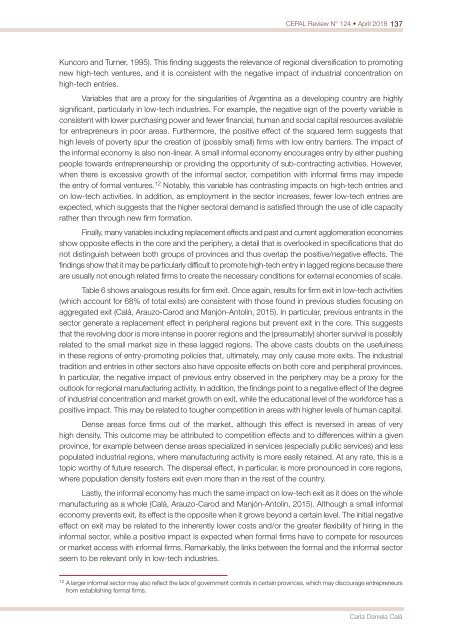CEPAL Review no. 124
April 2018
April 2018
You also want an ePaper? Increase the reach of your titles
YUMPU automatically turns print PDFs into web optimized ePapers that Google loves.
<strong>CEPAL</strong> <strong>Review</strong> N° <strong>124</strong> • April 2018 137<br />
Kuncoro and Turner, 1995). This finding suggests the relevance of regional diversification to promoting<br />
new high-tech ventures, and it is consistent with the negative impact of industrial concentration on<br />
high-tech entries.<br />
Variables that are a proxy for the singularities of Argentina as a developing country are highly<br />
significant, particularly in low-tech industries. For example, the negative sign of the poverty variable is<br />
consistent with lower purchasing power and fewer financial, human and social capital resources available<br />
for entrepreneurs in poor areas. Furthermore, the positive effect of the squared term suggests that<br />
high levels of poverty spur the creation of (possibly small) firms with low entry barriers. The impact of<br />
the informal eco<strong>no</strong>my is also <strong>no</strong>n-linear. A small informal eco<strong>no</strong>my encourages entry by either pushing<br />
people towards entrepreneurship or providing the opportunity of sub-contracting activities. However,<br />
when there is excessive growth of the informal sector, competition with informal firms may impede<br />
the entry of formal ventures. 12 Notably, this variable has contrasting impacts on high-tech entries and<br />
on low-tech activities. In addition, as employment in the sector increases, fewer low-tech entries are<br />
expected, which suggests that the higher sectoral demand is satisfied through the use of idle capacity<br />
rather than through new firm formation.<br />
Finally, many variables including replacement effects and past and current agglomeration eco<strong>no</strong>mies<br />
show opposite effects in the core and the periphery, a detail that is overlooked in specifications that do<br />
<strong>no</strong>t distinguish between both groups of provinces and thus overlap the positive/negative effects. The<br />
findings show that it may be particularly difficult to promote high-tech entry in lagged regions because there<br />
are usually <strong>no</strong>t e<strong>no</strong>ugh related firms to create the necessary conditions for external eco<strong>no</strong>mies of scale.<br />
Table 6 shows analogous results for firm exit. Once again, results for firm exit in low-tech activities<br />
(which account for 68% of total exits) are consistent with those found in previous studies focusing on<br />
aggregated exit (Calá, Arauzo-Carod and Manjón-Antolín, 2015). In particular, previous entrants in the<br />
sector generate a replacement effect in peripheral regions but prevent exit in the core. This suggests<br />
that the revolving door is more intense in poorer regions and the (presumably) shorter survival is possibly<br />
related to the small market size in these lagged regions. The above casts doubts on the usefulness<br />
in these regions of entry-promoting policies that, ultimately, may only cause more exits. The industrial<br />
tradition and entries in other sectors also have opposite effects on both core and peripheral provinces.<br />
In particular, the negative impact of previous entry observed in the periphery may be a proxy for the<br />
outlook for regional manufacturing activity. In addition, the findings point to a negative effect of the degree<br />
of industrial concentration and market growth on exit, while the educational level of the workforce has a<br />
positive impact. This may be related to tougher competition in areas with higher levels of human capital.<br />
Dense areas force firms out of the market, although this effect is reversed in areas of very<br />
high density. This outcome may be attributed to competition effects and to differences within a given<br />
province, for example between dense areas specialized in services (especially public services) and less<br />
populated industrial regions, where manufacturing activity is more easily retained. At any rate, this is a<br />
topic worthy of future research. The dispersal effect, in particular, is more pro<strong>no</strong>unced in core regions,<br />
where population density fosters exit even more than in the rest of the country.<br />
Lastly, the informal eco<strong>no</strong>my has much the same impact on low-tech exit as it does on the whole<br />
manufacturing as a whole (Calá, Arauzo-Carod and Manjón-Antolín, 2015). Although a small informal<br />
eco<strong>no</strong>my prevents exit, its effect is the opposite when it grows beyond a certain level. The initial negative<br />
effect on exit may be related to the inherently lower costs and/or the greater flexibility of hiring in the<br />
informal sector, while a positive impact is expected when formal firms have to compete for resources<br />
or market access with informal firms. Remarkably, the links between the formal and the informal sector<br />
seem to be relevant only in low-tech industries.<br />
12<br />
A larger informal sector may also reflect the lack of government controls in certain provinces, which may discourage entrepreneurs<br />
from establishing formal firms.<br />
Carla Daniela Calá


















